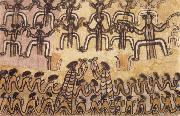|
|
|
|
 |
| Click Image to Enlarge |
Ceremony late 1890s
new9/William Barak-768345.jpg
|
|
|
|
|
Ceremony_late_1890s
mk80
pencil,wash,ground wash,charcoal solution,
gouache and earth pigments on paper
57x88.8cm
|
|
|
| Prev Artist Next Artist
|
|
William_Barak
Australian Aboriginal, ca.1824-1903
was the last traditional ngurungaeta (elder) of the Wurundjeri-willam clan, based around the area of present-day Melbourne, Australia. He became an influential spokesman for Aboriginal social justice and an important informant on Wurundjeri cultural lore. Barak was born in the early 1820s at Brushy Creek near present-day Croydon, in the country of the Wurundjeri people. His mother, Tooterrie, came from the Nourailum bulluk at Murchison, Victoria. His father, Bebejern, was an important member of the Wurundjeri clan. Beruk was said to have been present when John Batman met with the tribal elders to 'purchase' the Melbourne area in 1835. Before he died he described witnessing the signing of the treaty in a ceremony he called a tanderem. Ninggalobin, Poleorong and Billibellary were the leading song makers and principal Wurundjeri leaders in the Melbourne region. European colonisation had caused disruptions to initiation ceremonies. In response these three men gathered at South Yarra in the late 1830s and inducted the young William Barak into Aboriginal lore. This entailed formally presenting Barak with the symbols of manhood: strips of possumskin tied around his biceps; the gombert around his neck; given his ilbi-jerri, a sharp and narrow bone or nose-peg; and his branjep, the apron worn by men to cover their genitals. At the end of the ceremony Barack presented his uncle, Billibellary, a possumskin cloak. Beruk attended the government's Yarra Mission School from 1837 to 1839. When he joined the Native Mounted Police in 1844, he was given the name of William Barak. He was Police Trooper No.19. In early 1863, Barak moved to Coranderrk Station, near Healesville, Victoria with about thirty others. Upon the death of Simon Wonga in 1875, Barak became the Ngurungaeta of the clan. He worked tirelessly for his people and was a successful negotiator on their behalf. He was a highly respected man and leader, with standing amongst the Indigenous people and the European settlers. Figures in possum-skin cloaks, 1898 by William Barak.Barak is now best remembered for his artworks, which show both traditional Indigenous life and encounters with Europeans. Most of Barak's drawings were completed at Coranderrk during the 1880s and 1890s. They are now highly prized and exhibited in leading public galleries in Australia. His work is on permanent display in the National Gallery of Victoria Ian Potter Centre at Federation Square, Melbourne. Ceremony (1895) is housed at the Ballarat Fine Art Gallery. Barak died at Coranderrk in 1903 and is buried at the Coranderrk cemetery.
|
|
| Wholesale China Oil Painting Wholesale Oil Painting China Xiamen Portrait Reproduction on canvas Chinese Oil Painting Wholesale USA Oil Painting |
|
|
|
|